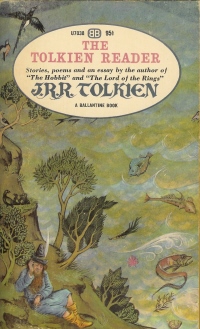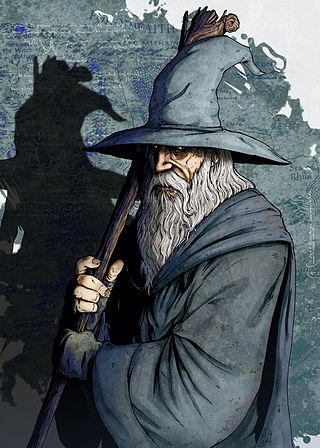
The Battle of Maldon took place on 11 August 991 AD near Maldon beside the River Blackwater in Essex, England, during the reign of Æthelred the Unready. Earl Byrhtnoth and his thegns led the English against a Viking invasion. The battle ended in an Anglo-Saxon defeat. After the battle Archbishop Sigeric of Canterbury and the aldermen of the south-western provinces advised King Æthelred to buy off the Vikings rather than continue the armed struggle. The result was a payment of Danegeld of 10,000 Roman pounds (3,300 kg) of silver.
Denethor II, son of Ecthelion II, is a fictional character in J. R. R. Tolkien's novel The Lord of the Rings. He was the 26th ruling Steward of Gondor, committing suicide in the besieged city of Minas Tirith during the Battle of the Pelennor Fields.
In J. R. R. Tolkien's Middle-earth fiction, Man and Men denote humans, whether male or female, in contrast to Elves, Dwarves, Orcs, and other humanoid races. Men are described as the second or younger people, created after the Elves, and differing from them in being mortal. Along with Ents and Dwarves, these are the "free peoples" of Middle-earth, differing from the enslaved peoples such as Orcs.

Byrhtnoth, Ealdorman of Essex, died at the Battle of Maldon. His name is composed of the Old English beorht (bright) and noþ (courage). He is the subject of The Battle of Maldon, an Old English poem; J.R.R. Tolkien's short play in verse, The Homecoming of Beorhtnoth, Beorhthelm's Son; and a modern statue at Maldon.

The Tolkien Reader is an anthology of works by J. R. R. Tolkien. It includes a variety of short stories, poems, a play and some non-fiction. It compiles material previously published as three separate shorter books, together with one additional piece and introductory material. It was published in 1966 by Ballantine Books in the USA.
This is a list of all published works of the English writer and philologist J. R. R. Tolkien. Tolkien's works were published before and after his death.
"The Council of Elrond" is the second chapter of Book 2 of J. R. R. Tolkien's bestselling fantasy work, The Lord of the Rings, which was published in 1954–1955. It is the longest chapter in that book at some 15,000 words, and critical for explaining the power and threat of the One Ring, for introducing the final members of the Fellowship of the Ring, and for defining the planned quest to destroy it. Contrary to the maxim "Show, don't tell", the chapter consists mainly of people talking; the action is, as in an earlier chapter "The Shadow of the Past", narrated, largely by the Wizard Gandalf, in flashback. The chapter parallels the far simpler Beorn chapter in The Hobbit, which similarly presents a culture-clash of modern with ancient. The Tolkien scholar Tom Shippey calls the chapter "a largely unappreciated tour de force". The Episcopal priest Fleming Rutledge writes that the chapter brings the hidden narrative of Christianity in The Lord of the Rings close to the surface.
Peregrin Took, commonly known simply as Pippin, is a fictional character from J. R. R. Tolkien's fantasy novel The Lord of the Rings. He is closely tied with his friend and cousin, Merry Brandybuck, and the two are together during most of the story. Pippin and Merry are introduced as a pair of young hobbits of the Shire who become ensnared in their friend Frodo Baggins's quest to destroy the One Ring. Pippin joins the Fellowship of the Ring. He and Merry become separated from the rest of the group at the breaking of the Fellowship and spend much of The Two Towers with their own story line. Impetuous and curious, Pippin enlists as a soldier in the army of Gondor and fights in the Battle of the Morannon. With the other hobbits, he returns home, helps to lead the Scouring of the Shire, and becomes Thain or hereditary leader of the land.

The Wizards or Istari in J. R. R. Tolkien's fiction were powerful angelic beings, Maiar, who took the form of Men to intervene in the affairs of Middle-earth in the Third Age, after catastrophically violent direct interventions by the Valar, and indeed by the one god Eru Ilúvatar, in the earlier ages.

"The Battle of Maldon" is the name given to an Old English poem of uncertain date celebrating the real Battle of Maldon of 991, at which an Anglo-Saxon army failed to repulse a Viking raid. Only 325 lines of the poem are extant; both the beginning and the ending are lost.
The poetry in The Lord of the Rings consists of the poems and songs written by J. R. R. Tolkien, interspersed with the prose of his high fantasy novel of Middle-earth, The Lord of the Rings. The book contains over 60 pieces of verse of many kinds; some poems related to the book were published separately. Seven of Tolkien's songs, all but one from The Lord of the Rings, were made into a song-cycle, The Road Goes Ever On, set to music by Donald Swann. All the poems in The Lord of the Rings were set to music and published on CDs by The Tolkien Ensemble.
The theme of addiction to power in The Lord of the Rings is central, as the Ring, made by the Dark Lord Sauron to enable him to take over the whole of Middle-earth, progressively corrupts the mind of its owner to use the Ring for evil.
The prose style of J. R. R. Tolkien's Middle-earth books, especially The Lord of the Rings, is remarkably varied. Commentators have noted that Tolkien selected linguistic registers to suit different peoples, such as simple and modern for Hobbits and more archaic for Dwarves, Elves, and the Rohirrim. This allowed him to use the Hobbits to mediate between the modern reader and the heroic and archaic realm of fantasy. The Orcs, too, are depicted in different voices: the Orc-leader Grishnákh speaks in bullying tones, while the minor functionary Gorbag uses grumbling modern speech.
J. R. R. Tolkien's presentation of heroism in The Lord of the Rings is based on medieval tradition, but modifies it, as there is no single hero but a combination of heroes with contrasting attributes. Aragorn is the man born to be a hero, of a line of kings; he emerges from the wilds and is uniformly bold and restrained. Frodo is an unheroic, home-loving Hobbit who has heroism thrust upon him when he learns that the ring he has inherited from his cousin Bilbo is the One Ring that would enable the Dark Lord Sauron to dominate the whole of Middle-earth. His servant Sam sets out to take care of his beloved master, and rises through the privations of the quest to destroy the Ring to become heroic.
The medievalist and fantasy author J. R. R. Tolkien derived the characters, stories, places, and languages of Middle-earth from many sources. Among these are Norse mythology, which depicts a reckless bravery that Tolkien named Northern courage. For Tolkien, this was exemplified by the way the gods of Norse mythology knew they would die in the last battle, Ragnarök, but they went to fight anyway. He was influenced, too, by the Old English poems Beowulf and The Battle of Maldon, which both praise heroic courage. He hoped to construct a mythology for England, as little had survived from its pre-Christian mythology. Arguing that there had been a "fundamentally similar heroic temper" in England and Scandinavia, he fused elements from other northern European regions, both Norse and Celtic, with what he could find from England itself.

The Keys of Middle-earth: Discovering Medieval Literature Through the Fiction of J.R.R. Tolkien is a 2005 book by Stuart Lee and Elizabeth Solopova. It is meant to provide an understanding of J. R. R. Tolkien's Middle-earth fantasy writings in the context of medieval literature, including Old and Middle English and Old Norse, but excluding other relevant languages such as Finnish.

Tolkien's Art: 'A Mythology for England' is a 1979 book of Tolkien scholarship by Jane Chance, writing then as Jane Chance Nitzsche. The book looks in turn at Tolkien's essays "On Fairy-Stories" and "Beowulf: The Monsters and the Critics"; The Hobbit; the fairy-stories "Leaf by Niggle" and "Smith of Wootton Major"; the minor works "Lay of Autrou and Itroun", "The Homecoming of Beorhtnoth", "Imram", and Farmer Giles of Ham; The Lord of the Rings; and very briefly in the concluding section, The Silmarillion. In 2001, a second edition extended all the chapters but still treated The Silmarillion, that Tolkien worked on throughout his life, as a sort of coda.
J. R. R. Tolkien derived the characters, stories, places, and languages of Middle-earth from many sources. Shakespeare's influence on Tolkien was substantial, despite Tolkien's professed dislike of the playwright. Tolkien disapproved in particular of Shakespeare's devaluation of elves, and was deeply disappointed by the prosaic explanation of how Birnam Wood came to Dunsinane Hill in Macbeth. Tolkien was influenced especially by Macbeth and A Midsummer Night's Dream, and he used King Lear for "issues of kingship, madness, and succession". He arguably drew on several other plays, including The Merchant of Venice, Henry IV, Part 1, and Love's Labour's Lost, as well as Shakespeare's poetry, for numerous effects in his Middle-earth writings. The Tolkien scholar Tom Shippey suggests that Tolkien may even have felt a kind of fellow-feeling with Shakespeare, as both men were rooted in the county of Warwickshire.
J. R. R. Tolkien repeatedly dealt with the theme of death and immortality in Middle-earth. He stated directly that the "real theme" of The Lord of the Rings was "Death and Immortality." In Middle-earth, Men are mortal, while Elves are immortal. One of his stories, The Tale of Aragorn and Arwen, explores the willing choice of death through the love of an immortal Elf for a mortal Man. He several times revisited the Old Norse theme of the mountain tomb, containing treasure along with the dead and visited by fighting. He brought multiple leading evil characters in The Lord of the Rings to a fiery end, including Gollum, the Nazgûl, the Dark Lord Sauron, and the evil Wizard Saruman, while in The Hobbit, the dragon Smaug is killed. Their destruction contrasts with the heroic deaths of two leaders of the free peoples, Théoden of Rohan and Boromir of Gondor, reflecting the early Medieval ideal of Northern courage. Despite these pagan themes, the work contains hints of Christianity, such as of the resurrection of Christ, as when the Lord of the Nazgûl, thinking himself victorious, calls himself Death, only to be answered by the crowing of a cockerel. There are, too, hints that the Elvish land of Lothlórien represents an Earthly Paradise. Scholars have commented that Tolkien clearly moved during his career from being oriented towards pagan themes to a more Christian theology.








